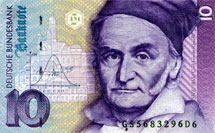

The German 10-Mark note (pre-Euro) featured Carl Friederich Gauß and his equation describing the “normal curve” of probability distribution.
Three crushing lessons lie in wait for almost every man if he lives long enough. He discovers that he is thoroughly resistible. He discovers that he is entirely replaceable. Most terrible of all he discovers he is completely forgettable. One has to be an Einstein, a Shakespeare a Rembrandt, a Mozart, or a Molière to escape the fate of the millions of brilliant and talented men who, since the beginning of recorded history, were celebrated by their contemporaries, but already half forgotten on the way home from their funerals. (p. x)
To the scientist, age comes as a surprise – a rather unfair surprise. He has been so busy all along with his eyes on the distant future that he is shocked to discover that his own biological life span has been ticking off on a shorter time scale. The brilliant young men of twenty-five who worked out the elements of the quantum theory in the 1920’s suddenly find themselves men of seventy when their once-strange ideas are at last being accepted as part of conventional thought. What a cruel joke it must seem to men who spent so much time being the radical young innovators! Hermann Minkowski, the mathematician who put Einstein’s special relativity theory into the elegant form which gave rise to the idea of the ‘fourth dimension,’ sighed as he lay waiting for death: ‘What a pity to have to die just when relativity is about to be recognized.’ (p. xi)
Wilson, Mitchell, Passion to Know: The World’s Scientists, Doubleday & Company, Inc., 1972.
